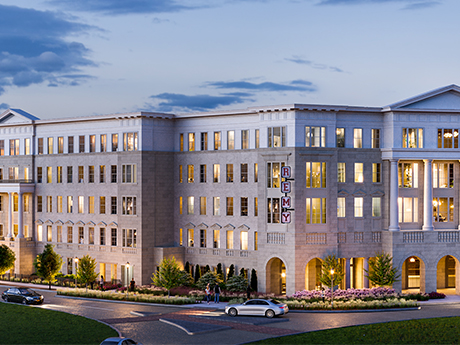By Kevin Leamy, senior vice president, debt & equity, Northmarq
Dallas-Fort Worth (DFW) has been one of the hottest multifamily markets in the country over the past five years. And as the area’s growth pushes further north, developers and investors are finding plenty of liquidity to support transactions.
The northern DFW suburbs experienced a huge inflow of people over the past several years. The growth to suburbs such as Addison, Richardson, Plano, Frisco and McKinney gained even more traction during the pandemic.

Kevin Leamy, Northmarq
An increasingly diverse employer base and corresponding job growth are attracting people and driving demand for both for-sale homes and multifamily units. Instead of making a long commute into downtown Dallas or Fort Worth, there are now several big employers in North Dallas that offer
high-quality jobs.
One key catalyst for expansion was the opening of Toyota’s North American headquarters in Plano five years ago. The 100-acre campus is home to more than 4,000 employees. Other major corporations have followed, including the newly opened regional headquarters for J.P. Morgan Chase. Another factor drawing new residents to the area is strong schools, including a reputation for some of the best elementary and high schools in the country.
Multifamily developers have seized on the growing demand, and they are following the Dallas North Tollway and U.S. Highway 75 north in pursuit of new projects. Merchant builders are constructing these projects in 18 to 24 months, stabilizing rent rolls and then selling after 36 months.
Behind them is a deep pool of investors, often with longer-term hold strategies. Whether developers are looking for short-term construction and bridge financing or long-term fixed-rate debt, there are plenty of options available.
Strong Lender Appetite
Lenders are seeing the same strong fundamentals as developers and investors, and they have a healthy appetite to execute deals in the market.
Despite recent upticks in interest rates, borrowers are still finding plenty of liquidity. Banks are providing financing, as are life insurance companies and debt funds. In particular, Fannie Mae, Freddie Mac and FHA/HUD represent the most efficient and lowest-cost sources of capital.
The agencies have all been very active in financing multifamily projects in these North Dallas markets. In fact, Fannie Mae relocated its own regional headquarters to Plano at the end of 2017. The agencies are active across the spectrum of properties from market-rate to more mission-driven affordable product.
Overall, the agencies are focusing on creating balanced portfolios, and they are lending for all types of multifamily subcategories and at all stages of the project life cycle in these northern suburbs.
For example, Northmarq recently arranged agency financing for a multifamily property located in North Dallas. The borrower had a long-term strategy and opted for a fixed-rate, full-term interest-only loan. The asset was located within a great school district and in excellent proximity to an abundance of employers.
In the third quarter of 2021, Northmarq also closed on financing for a four-property multifamily portfolio that includes two assets in Allen. The transaction involved an institutional buyer, with financing provided by a large debt fund based out of New York City. The deal highlights the growing interest coming from large institutions and coastal capital to not only enter the Sun Belt region and Texas market, but North Dallas specifically.
We are seeing some transactions in the market occur at negative leverage, or at cap rates that are beneath the all-in borrowing cost. Investors still see this value proposition with multifamily investments, especially if those assets are in markets such as North Dallas or other parts of the Sun Belt.
Fundamentals have continued to remain strong, allowing for above-average rent growth, which gives comfort to buyers and investors when they are analyzing a potential acquisition with negative leverage going in.
With that said, there are plenty of transactions occurring with financing costs that are still beneath in-place cap rates. We are seeing investors and buyers utilize floating-rate debt coupled with the purchase of aggressive interest rate caps that are limiting their overall rate exposure.
More Growth Ahead
The DFW multifamily market continues to perform well, with vacancy rates at 3.9 percent in the second quarter and rent growth that was approaching nearly 20 percent year-over-year, according to Northmarq’s market research. Property owners in the northern suburbs are experiencing much the same phenomenon, with new projects that are leasing quickly.
Another factor contributing to that strong rental demand is high barriers for home buyers. The median cost of a single-family home in North Dallas now exceeds $600,000. So even though rental rates have jumped, there is still a big discount to renting versus owning a home in the market.
Higher mortgage rates following Fed rate hikes make homeownership more expensive for buyers and will likely drive more multifamily development in the northern part of the metroplex.
The majority of new projects are garden-style apartments with surface parking. Developers are also taking advantage of tax incentives to include affordability components in new projects. Builders can get tax breaks if they keep 20 percent of units affordable with rents that are below 80 percent of the area median income (AMI).
In addition, there are more Class A wrap, podium and high-rise properties being built just north of The Star in Frisco. The Star is the 91-acre headquarters and practice facility for the Dallas Cowboys, and builders are designing projects that cater to the high demographics in the neighborhoods of Stonebriar and Starwood.
Thus far, new projects are seeing very successful lease-ups and strong renter profiles, and developers are easily achieving their pro forma rents. Double-digit rent growth is expected to normalize at some point, although Northmarq does expect rent growth to continue in the range of 3 to 10 percent for the foreseeable future.
Lenders are keeping an eye on one of the biggest market risks — the potential for oversupply due to abundant land and low barriers to entry. However, the near-term outlook remains incredibly positive, with a staggering amount of people moving to the northern suburbs and driving demand for all types of
housing.


